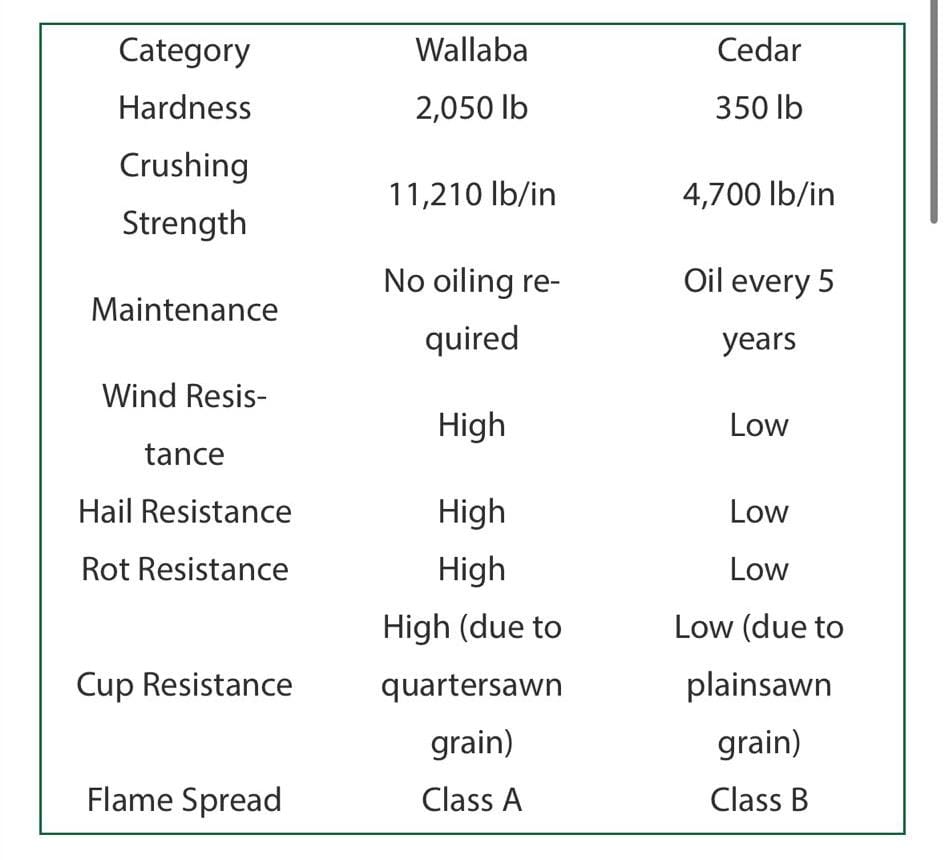Wallaba Shingles vs. Cedar Shingle: A Comprehensive Overview
Exploring the Superiority of Wallaba
 Ever wondered about Wallaba? It’s a dense tropical hardwood cultivated in the forests of Suriname, Guyana, and Brazil. Displaying a light red to reddish-brown hue, Wallaba wood is characterized by high density and a coarse texture with typically straight grain. Enriched with gum exudates and oily resin, Wallaba possesses inherent properties that combat insects and decay. Historically, it has been prized for applications such as shingles and transmission poles, with additional uses spanning railroad ties, industrial flooring, decking, fence posts, and more.
Ever wondered about Wallaba? It’s a dense tropical hardwood cultivated in the forests of Suriname, Guyana, and Brazil. Displaying a light red to reddish-brown hue, Wallaba wood is characterized by high density and a coarse texture with typically straight grain. Enriched with gum exudates and oily resin, Wallaba possesses inherent properties that combat insects and decay. Historically, it has been prized for applications such as shingles and transmission poles, with additional uses spanning railroad ties, industrial flooring, decking, fence posts, and more.
Wallaba Shingles vs. Cedar Shingle: A Detailed Comparison
Peruse the table above to witness the natural superiority of Wallaba shingles over Cedar shingles. At TLS Shingles, we’re not discouraging the use of cedar shingles; we’re simply enlightening you about a superior alternative!
Environmental Impact Considerations
The ecological footprint matters, and here’s where Wallaba Hardwood Shingles shine. Unlike traditional cedar shingles, Wallaba shingles don’t demand chemical treatments, making them a more environmentally conscious choice.
For a deeper dive into the comparison, feel free to explore our official study here.
Elevate your roofing choices with Wallaba Shingles—a blend of performance, sustainability, and natural beauty.

Embrace the Superiority of Wallaba Shingles over Cedar
Forget about the fleeting allure of cedar wood shingles for your home’s roof. While the initial aesthetic appeal may satisfy you for a brief period, it won’t be long before your cedar shingles lose their luster, appearing aged beyond their years. Fortunately, there’s a game-changing alternative offered by TLS Hardwood Shingles: Wallaba.
Exceptional Shakes Redefined
Wooden shakes undeniably evoke a classic and timeless roof aesthetic. However, the commonplace cedar shakes fall short in maintaining their appearance and performance over the years. Cedar demands costly treatments and meticulous upkeep to extend its lifespan, paling in comparison to the untreated resilience of Wallaba.
Untreated Wallaba surpasses treated cedar by lasting twice as long— an impressive 40+ years versus cedar’s meager 10 to 20 years. Wallaba exhibits heightened resistance to fire, decay, and even hurricanes—challenges that cedar struggles to endure. Moreover, Wallaba weathers gracefully, transitioning from a vibrant red to a striking silver tone, while cedar fades from a weak red to a dull gray.
Discover the Wallaba Advantage
Elevate your roofing experience with Wallaba, a choice that goes beyond aesthetics. Wallaba stands strong against the test of time, offering not only enduring beauty but also unmatched resilience. Say goodbye to the limitations of cedar and explore the exceptional qualities of Wallaba. If you’re curious to learn more about our Wallaba alternative to cedar shakes, simply fill out our contact form. Your roofing upgrade awaits!
